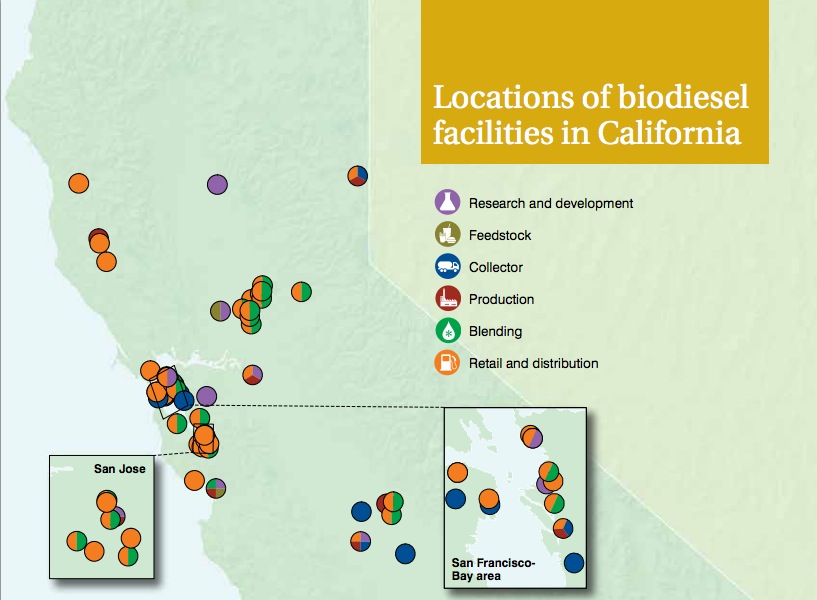ENVIRONMENTAL DEFENSE FUND
ENVIRONMENTAL ENTREPRENEURS (E2)
The Biodiesel Fuel Value Chain
Biodiesel is a renewable alternative to traditional diesel. It is made from feedstocks (raw materials) such as oils and recycled cooking grease, rather than fossil fuels. Biodiesel is commonly blended with traditional diesel, but is also sold in its pure form. It has considerably fewer emissions than its traditional counterpart and because much of the feedstock used in California is from the state, it reduces dependence on foreign sources. Successful growth of the companies profiled here demonstrates that the industry is creating jobs inCalifornia and growing the economy. EDF profiled one company to represent each step of the value chain:research and development, feedstock, collection, production, blending, and retail and distribution.
RESEARCH AND DEVELOPMENT
Biodiesel companies that participate in Research and Development (R&D) work to identify new resources that can be used as feedstock or new process and technology breakthroughs that can accelerate the development and commercialization of cleaner diesel. these companies work to integrate science and engineering research to improve processing, conversion, storage, and product development and analysis.
FEEDSTOCK
Biodiesel feedstock is the raw material that makes the fuel. typical feedstocks are plant oils like soybean and canola; however lowercarbon footprint feedstocks like used cooking oil are also used by biodiesel producers. new feedstocks currently under investigation include algae and even sewage sludge. abundant and steady sources of feedstock allow for biodesel to be scaled economically.
COLLECTION
Biodiesel companies partner with restaurants and food service companies that produce waste grease in order to have readily available feedstock to use in biodiesel production. Biodiesel companies will either pick up grease that has been safely stored in drums, or pump the waste grease from the restaurants directly into a truck for transportation to the production facility.
PRODUCTION
Biodiesel is produced through a process called “transesterification.” in this process, glycerin (a colorless, odorless, syrupy liquid made from fats and oils) is separated from the fat or vegetable oil, leaving behind methyl esters (the scientific name for biodiesel) and glycerin (a byproduct that can be reused in soaps and other products).
BLENDING
Many companies produce blends of biodiesel and traditional diesel, though pure biodiesel is available commercially. Common blends are B5 (5% biodiesel) and B20 (20% biodiesel). all blends must meet american society for testing and materials standards. today, blends are affordable due to smart policies like the low Carbon fuel standard (lCfs) and the Renewable fuel standard.
RETAIL AND DISTRIBUTION
Finally, biodiesel companies must distribute and sell their products. some companies, like imperial Western products (iWp), deliver the product to business customers who then blend and distribute the product further. other companies, like propel, sell their biodiesel blends directly to consumers as a cleaner alternative at fuel stations across the state.
Download full version (PDF): Biodiesel in California
About The Environmental Defense Fund
www.edf.org
The Environmental Defense Fund is “a leading national nonprofit organization, which creates transformational solutions to the most serious environmental problems. The Environmental Defense Fund (EDF) links science, economics, law and innovative private-sector partnerships.
About Environmental Entrepreneurs (E2)
e2.org
“Environmental Entrepreneurs (E2) is a national community of business leaders who promote sound environmental policy that builds economic prosperity. We provide an independent, nonpartisan resource for understanding the business perspective on environmental issues. Working with business, environmental and non-traditional allies, E2 helps shape state and national policy that’s good for the economy and the environment.”
Tags: Biodiesel, CA, California, E2, EDF, Environmental Defense Fund, Environmental Entrepreneurs







 RSS Feed
RSS Feed